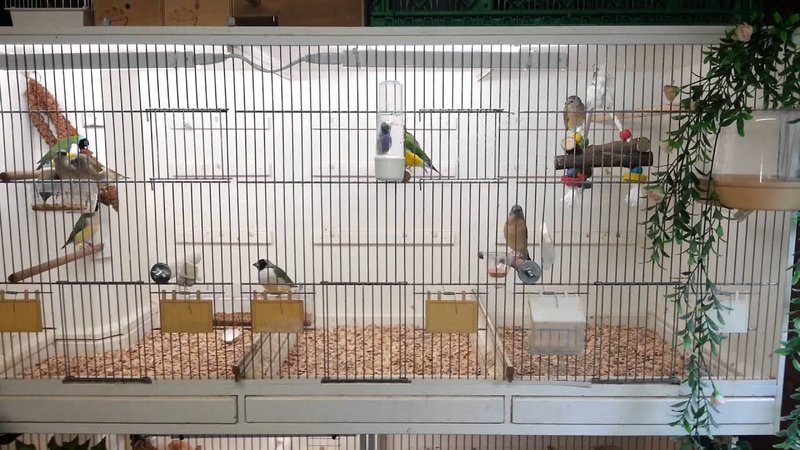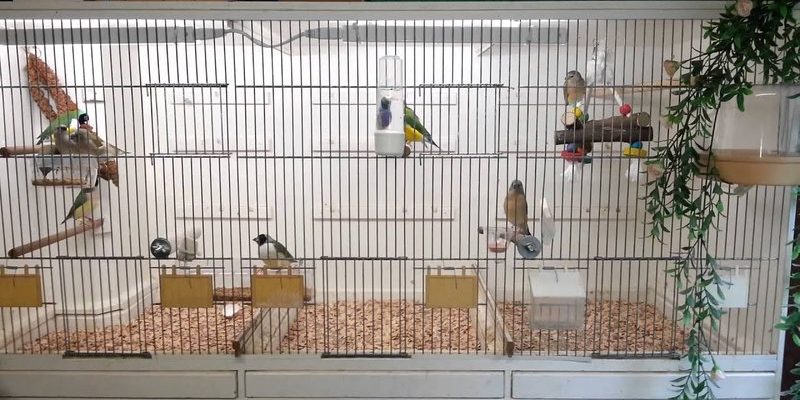
When it comes to finches, they’re more than just chirpy little creatures. They’re lively and social, and they love to explore and hop around their space! So, having the right cage size, choosing appropriate perches, and providing nesting materials are crucial. Whether you have a society finch, a zebra finch, or any other type, these tips will help you create a delightful home for them.
The Right Size For Your Finch Cage
Choosing the right size cage for your finches is the foundation of their setup. Think of it like picking out a new apartment—too small, and they’ll feel cramped; too big, and it might be overwhelming. A good rule of thumb is to provide at least 30 inches long, 18 inches wide, and 18 inches high for a small flock of finches. The taller the cage, the more they can fly and hop around, which helps keep them lively.
But don’t just settle for the minimum size. The more space, the better! If your budget allows, opt for larger cages. Finches are naturally active birds, and they thrive in environments where they can move freely. If you can, aim for a flight cage or aviary style, which provides horizontal and vertical space for them to play and fly.
Keep in mind that multiple finches should have their own space. It’s like living with roommates; they need their areas while still being close enough to socialize. A cage that comfortably fits a few finches will encourage bonding and reduce stress.
Choosing the Right Perches
Perches might seem like an afterthought, but they’re essential for your finches’ comfort. Just like we enjoy lounging on different types of furniture, finches appreciate variety too. Think about adding a mix of natural wood perches and platforms. Natural wood perches, like eucalyptus or pine, give them a textured surface that mimics their natural habitat. Plus, they’re more fun to grip than plain dowels!
The size of the perches matters too. You want a range of diameters for their feet to grip. A mix of thin and thick perches prevents foot problems and keeps their little feet happy. Most finches enjoy perches that are about 1⁄2 inch to 1 inch in diameter. You can even get creative with shapes; spiral perches, for instance, can provide a unique climbing experience!
Don’t forget about the placement—varying the heights of the perches can encourage movement. Finches love hopping from one to another, and it keeps their bodies active. You might also want to avoid putting all perches near the food and water. This forces them to move around and explore their space more, which is excellent for their health.
Creating Cozy Nesting Areas
Nesting is an essential part of your finches’ life, especially if you have a breeding pair. You want to make sure they feel safe and secure when they’re ready to settle down. Think of it like setting up a nursery for new parents. Providing proper nesting materials can help create that special place.
Start with a nesting box or basket. Look for one that’s about 6 inches high and 6 inches wide. Finches prefer enclosed spaces, so having a box with a small entrance works best. It mimics their natural surroundings and gives them a place to hide away.
Now, let’s talk about nesting materials. Finches are fans of soft, cozy items. You can offer a mix of soft grasses, coconut fiber, and shredded paper. These materials are excellent for warmth and comfort. Avoid anything synthetic, as it can be harmful to their health. If you’re unsure what to use, check your local pet store for specially formulated nesting materials that cater to small birds!
If you notice your finches are actively using the nesting area, that’s a great sign! They’re feeling comfy and ready to raise a family. Just make sure to check on them regularly and help them out by adding fresh materials when needed.
Maintaining Cleanliness in the Cage
A clean environment is crucial for your finches’ health. Picture it like keeping your own home tidy; a clean space helps everyone feel better and stay healthy. Regular cleaning prevents bacteria growth and keeps your birds happy.
Start by cleaning the cage every week. Remove old food, droppings, and any dirty bedding. Use a safe, pet-friendly disinfectant to wipe down surfaces. Remember to rinse thoroughly to remove any residues. It’s important to avoid using strong chemicals that could harm your feathered friends.
You’ll also want to replace bedding and food regularly. Fresh food and clean water make a significant difference in their well-being. Some bird owners even set up a routine! For example, clean the cage every Saturday morning. This way, it becomes part of your weekly schedule, and your finches will always have a fresh and inviting home.
Providing Enrichment and Playtime
Finches are social creatures that thrive on interaction. Think of their cage as a playground! Incorporating toys and enrichment items can make their space more engaging. Items like swings, mirrors, and climbing structures can encourage play and exploration.
When choosing toys, look for bird-safe materials. Natural wood and untreated materials are always a safe bet. You might also consider rotating toys every month—this keeps things fresh and exciting. Just like kids with their favorite toys, your finches will love the new challenges!
Also, consider giving them time outside their cage regularly. Under supervision, you can let them explore a safe area, like a bird-proofed room. This not only helps in giving them exercise but also strengthens your bond. Just watch for any potential hazards in your home, like open windows or ceiling fans!
Final Touches: Lighting and Temperature
Finally, let’s not forget about lighting and temperature. Finches thrive in well-lit spaces, but direct sunlight can be harsh. You want to aim for about 12 hours of light each day, mimicking their natural environment. Natural light is best, but if that’s not possible, consider using a full-spectrum bird light. This helps keep their colors vibrant and energy levels high.
Temperature is also vital. Keeping your finches in an area that’s between 65°F to 75°F is ideal. Avoid placing the cage near drafts or heating vents, as temperature fluctuations can stress them out. A stable environment helps them feel safe and relaxed.
Overall, creating the perfect finch cage takes a little thought and effort, but it’s well worth it. When you see your finches flitting about happily, you’ll know you’ve done a fantastic job setting up their home!
In conclusion, your finches deserve a delightful and stimulating environment where they can thrive. By focusing on the cage size, perches, nesting options, cleanliness, enrichment, and a proper ambiance, you provide them with a wonderful life. So, enjoy the journey of creating the perfect home for your feathery friends—you’ll find it’s a rewarding experience!

